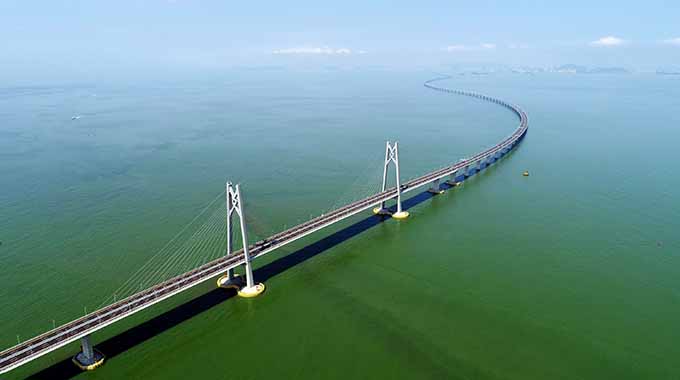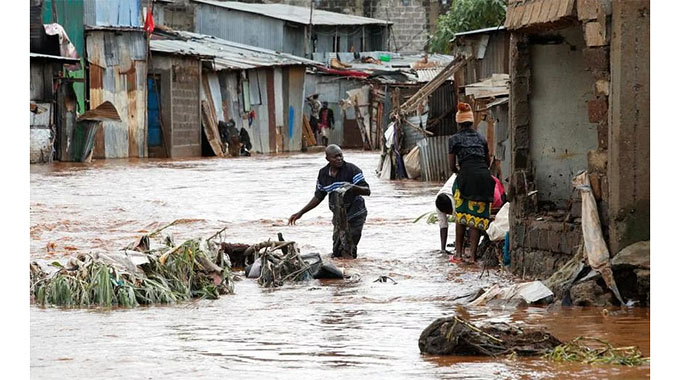World’s longest sea crossing: Hong Kong-Zhuhai bridge opens

BEIJING. – Chinese President Xi Jinping announced the opening of the Hong Kong-Zhuhai-Macao Bridge at a launch ceremony in the city of Zhuhai, Guangdong Province, on Tuesday morning.
On behalf of the Communist Party of China (CPC) Central Committee, President Xi, also general secretary of the CPC Central Committee and chairman of the Central Military Commission, expressed sincere thanks and warm greetings to those who participated in the design, building, and management of the bridge.
Han Zheng, vice premier and member of the Standing Committee of the Political Bureau of the CPC Central Committee, addressed the opening ceremony, which was held at a hall of the Zhuhai Port.
The 55-km bridge, situated in the waters of Lingdingyang of Pearl River Estuary, connects the Hong Kong Special Administrative Region (SAR), Zhuhai and the Macao SAR. The bridge is the first of its kind for Guangdong, Hong Kong, and Macao to jointly build a supergiant sea-crossing traffic project under the principle of “one country, two systems.”
During the inspection, President Xi ascended on a platform to overlook the bridge at the east artificial island, which is a key part of the bridge.
The bridge is a national project. “You participated in the design, building, and maintenance of the bridge, gave full play to your talents and wisdom, and accomplished the tasks with good quality and quantity,” President Xi said, adding that he is proud of such achievements.
Praising builders of the bridge for breaking a number of world records, President Xi said they demonstrate the nation’s spirit of striving to overcome any difficulties, the national strength, the innovative ability, and the aspiration to be the world’s best.
“With the bridge, we have further enhanced our confidence in the path, theory, system, and culture of socialism with Chinese characteristics,” President Xi said.
The bridge should not only be structurally sound but also well managed, in a bid to contribute to the development of the Guangdong-Hong Kong-Macao Greater Bay Area, he said.
The bridge will help improve personnel and trade exchanges among Guangdong, Hong Kong, and Macao, benefit the development of the area, and enhance the comprehensive competitiveness of the Pearl River Delta, Han said.
He stressed that the bridge is important for supporting Hong Kong and Macao in integrating their own development into the overall development of the country, and fully advancing mutually beneficial cooperation among the mainland, Hong Kong, and Macao.
The construction of the bridge began on December 15, 2009, and its main structure was completed on July 7, 2017.
The bridge will officially open to traffic on October 24.
Special features
According to BBC Chinese, the bridge cost about $20bn (£15.3bn).
Designed to withstand earthquakes and typhoons, it was built using 400,000 tonnes of steel, enough to build 60 Eiffel Towers in Paris, France.
About 30km of its total length crosses the sea of the Pearl River delta. To allow ships through, a 6.7km section in the middle dips into an undersea tunnel that runs between two artificial islands. The remaining sections are link roads, viaducts and land tunnels connecting Zhuhai and Hong Kong to the main bridge.
The bridge is part of China’s plan to create a Greater Bay Area, including Hong Kong, Macau and nine other cities in southern China.
The area is currently home to 68 million people. In the past, travelling between Zhuhai and Hong Kong would take up to four hours – the new bridge cuts this down to 30 minutes.
Who can across the bridge?
Those who want to cross the bridge must obtain special permits, allocated by a quota system. And all vehicles will pay a toll. The bridge is not served by public transport, so private shuttle buses will ply the route. There is no rail link.
Authorities initially estimated that 9,200 vehicles would cross the bridge every day. They later lowered their estimations after new transport networks were built in the region.
It’s fitted with ‘yawn cams’?
Special cameras will be on the look-out for drivers on the bridge who show signs of getting sleepy, among other checks – yawn three times and the authorities will be alerted, local media report.
To help counter potential terror attacks, there will also be “48 high-definition surveillance cameras”mounted at intervals along the bridge as well as anti-terror police patrols, the South China Morning Post reports.
And drivers will have to change which side of the road they are on at the crossing. People drive on the left in Hong Kong and Macau but the bridge is Chinese territory and special merger channels have been built to cope with this.
Costs
The bridge, surrounding link roads and artificial islands cost a staggering $20bn to build – the main bridge alone cost $6.92bn. Chinese officials say it will generate up to 10 trillion yuan ($1.44tn; £1tn) for the economy.
“I am not so sure either how the bridge can sustain itself if not many cars are using it,” Tanya Chan told BBC News Chinese.
“I am pretty sure that we would never earn that (construction cost) back.” According to an estimate by BBC Chinese, the bridge will only earn around $86m in tolls per year. – Xinhua/BBC Chinese/Herald reporter.







Comments